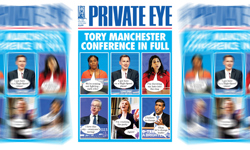My column this issue is, in many people’s eyes, going to make me seem like a sad, middle-aged geek. For which I make no apology! Let me explain…
I read recently that Marcus Rich, CEO of Time Inc UK, was a big fan of prog rock band, Marillion. Well, me too. Yes, I admit it: I love Marillion and have done since I was a teen in the late 80s, much to the chastisement of several ex-girlfriends subsequently, one of whom used to mock them as ‘sad men in capes’ (despite the fact I never saw any of them actually wear a cape in concert).
Two things here. Firstly, Marcus was quoted in early May as saying ‘digital magazine sales have plateaued’. This isn’t precisely what we’re seeing at Bauer, at least not on all our brands, but it’s certainly the case that the digital magazine market is hugely difficult. I’ll come back to that in a bit. Secondly, and this might surprise you, is the fact that Marillion – for all their awesome musical geekistry – are actually digital pioneers and brilliant marketers. Which as publishers, is what we need to be if we’re going to make our digital content grow and be profitable.
At the beginning of the century, Marillion was in a tricky situation. Faced with a problematic relationship with their record label and digital ‘threats’ to sales (sound familiar?), they embraced the internet and launched an online fan-funding model to get their 2001 album, Anoraknophobia, released. They’re largely credited with being one of the first artists, if not the first, to embrace such a strategy, digitally or otherwise. Utilising databases, their website, fantastic marketing and fan loyalty to the max, they secured upwards of 10,000 advance sales of the album.
Since then, their relationship with their audience has always been pivotal to their success. I’ve heard they have a database comprising in excess of 250,000 active fans, who they communicate with regularly, even when not releasing new music. Not bad for an ageing prog rock band. Their content is their music – it’s what glues and binds everything else together – but it’s the peripheral stuff that really makes it all work. The tours, fan conventions, merchandising, accessibility of the band and a key knowledge of the audience, what it is they want and how they want it delivered.
You can sample their music for free, they’ve embraced multimedia and social channels to increase reach and you can go to three-day conventions where the band attends events during the day, plays unique sets in the evenings and mingles with the audience afterwards.
Resultantly, their fans are fiercely loyal, happy to part with cash to buy tour tickets and new music, and love the band to bits; in a way few other musicians or bands are loved.
Just get out there
And so it should be for magazines and publishers. Editorial teams need to communicate with readers and enjoy it, or at least look like they’re enjoying it; not see it as a bind. Too many times in the past, I’ve heard a minority of editors moan and grumble at having to attend events and speak to readers; moan at having to communicate on Facebook or Twitter; push the management of social accounts and digital editions onto juniors or interns. It’s not good enough: teams need to attend events and be proactive in their social communications. We need to love our readers and embrace them, not push them away. And when from time to time, they get cross with us – maybe because the app isn’t working – we need to talk with them and sort it out.
The marketing we do at Bauer for our digital editions is absolutely crucial to our success. Without it, our digital editions business would be in decline, or worse. You can’t just launch digital magazine apps and leave them alone to fester in the face of continual software updates and device progression.
We’re constantly looking to improve our apps, the analytics and tracking thereof, and we’re working harder than ever with editorial teams to find out in advance, the content that’s coming out, provide free samples, socially promote it, raise awareness and grow and improve management of our data.
Data segmentation is particularly important. Within the legal parameters of what we can and can’t do with the data we have, we know if customers’ subs are about to expire, so we can market deals specifically to them to tempt a renewal. If they do expire, we can react accordingly with other bespoke offers. We know specifically what content people like. And, taking all this into account, we can send relevant pushes, emails, social updates, and so on. We can offer gifts to digital only subscribers, which on many of our brands, is a great USP.
Our focus is on growing our own platform digitally – in particular, our subscriber base, as opposed to single issue sales. All our learnings in the past indicate that while single issue promos can result in huge spikes in single issue sales, margin is negligible and once the promo is over, the trend line goes back to what it was before and there is thus no meaningful long-term revenue growth.
So we’re much more careful now with our marketing, more targeted. To use the music analogy, we promote the album as opposed to the song, giving the occasional songs away for free to show what we’re all about. Marillion has been doing that since the turn of the century.
While we’re delighted to work with the likes of Apple and Google and will always do so, the more people we can drive to buy through unique incentives and marketing deals via our own Great Magazines website, the better. And we love working with O2, McDonald’s and so on to drive awareness of digital editions through their Priority and Monopoly schemes respectively.
I mentioned that the digital magazine market was difficult. It is. Depending on the brand (the more specialist, the better) there is still growth to be had. But it’s bloody hard work knitting all the digital elements for success together and keeping them going.
So in 2016, in terms of revenues and downloads, we’re up both on plan and year-on-year, though not substantially. It’s tough. And I’m permanently aware that I’m working in such a fragile business that, if we were to take our foot off the pedal, the ramifications could be severe.
As for being digital pioneers – well, I can’t claim to be that, but our products are moving forwards in terms of functionality, reliability and how they fit in with editorial workflows. We have some exciting app updates and initiatives planned in the autumn. I can’t talk about these yet or I’d get a meeting request from HR in Room 13 (the ‘room of doom’ at Bauer, that arguably should be numbered ‘Room P45’!) At which point, I’d be calling Marcus Rich to ask him if he fancied going to a Marillion gig, where we could geek out to the music… and where I could seek alternative employment!












